Top News
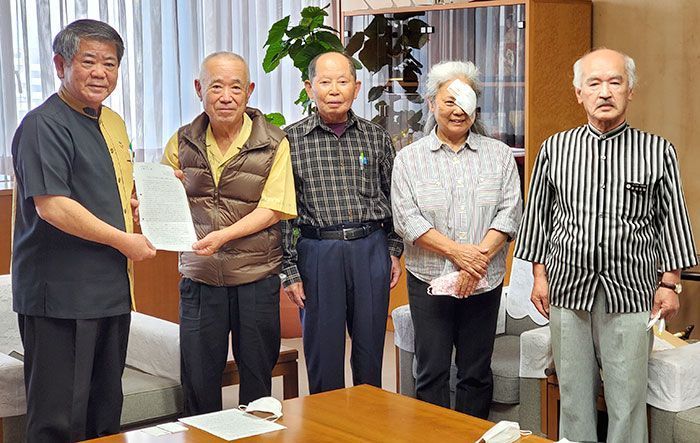
March 23, 2022 by Masanao Chinen
The “Uchina-guchi Kai,” an organization working to spread the Okinawan language led by Chosei Genga, visited Okinawan vice-governor Yoshimi Teruya at the Okinawa Prefectural Office on March 22, where they outlined the regulations in their request to make Uchina-guchi the “second official language” of Okinawa. This is the first time someone has submitted a written request for a second official language in Okinawa.
The written request asks that Uchina-guchi, which is used on tours and in Okinawan plays broadcast on television and radio, be designated the second official language as it is used in the role as a form of communication in Okinawa Prefecture.
Genga also noted that this would lead to “Ryukyuan and Okinawan people regaining their identity.”
Vice-governor Teruya conveyed his understanding of the importance of Uchina-guchi surviving into the future, but indicated that official languages “Need to be something that everyone can converse in.” The petition to make the language official is also being submitted to the Okinawa Prefectural Assembly, and the Prefectural government will continue to investigate this topic as it follows the discourse in the assembly.
(English translation by T&CT and Sam Grieb)
Go to Japanese
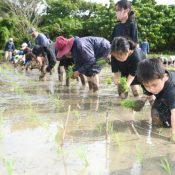
March 22, 2022 Ryukyu Shimpo
By Miho Iwakiri
Nago – On March 13, the Kayo Tabukwa Association, a group made up of residents of the Kayo neighborhood in Nago, planted rice in a neighborhood field for the first time in six years. Approximately 40 people worked up a sweat under a cloudless sky. Straw taken from the field will be used to make the rope for the neighborhood’s tug-of-war event to be held in the sixth month of the lunar year. The Kayo Tabukwa Association is made up of interested residents and volunteers from other areas. In the past, they borrowed a field of approximately 620 square meters for free from residents and cultivated rice by hand, without using pesticides. However, due to environmental changes and the coronavirus, the group has not done so since 2017.
This year, Hirofumi Miyagi of Kayo, who is a representative of the Tabukwa Association, Makoto Fujisaki of Abu, and Masato Ikei, who runs the Kaikadow after-school care and preparatory school in Naha, recruited the children who attend Kaikadow as well as volunteers from the south-central part of the island.
The association planted Haneji rice seedlings. For many children, it was their first time planting rice and they went at it with gusto, in spite of being unfamiliar with the work. One of the children, Koharu Chinen from Naha, said, “It’s fun sticking the seedlings into the mud.” Rice reaping and threshing will be done by hand in June and July. Miyagi says, “Kayo used to be the best place for growing rice in the Kushi of the old days. I want to share our culture of rice cultivation.”
(English translation by T&CT and Ellen Huntley)
Go to Japanese
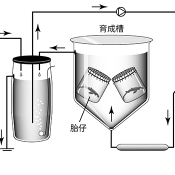
March 19, 2022 Ryukyu Shimpo
By Kotaro Nagamine
The Okinawa Churashima Foundation announced on March 8 that it succeeded in incubating embryos of the deep-water dwelling slendertail lantern shark (Etmopterus molleri) to birth in artificial uterine fluid, which mimics the body fluid of a shark. The feat is the first of its kind in the world.
The foundation has been developing an artificial uterus device for raising shark embryos outside the female body since 2017. In October 2020, a dead slendertail lantern shark carrying two live embryos was donated to the Okinawa Churaumi Aquarium. The embryos were placed in the device and successfully incubated for approximately five months. During this period the external yolks characteristic of an embryo, fully retracted and the embryos grew to birth size, about 1.5 times their initial length.
The artificial uterine fluid was developed to reduce environmental stress on the fetus. It co

An embryo of the deep-water dwelling slendertail lantern shark on day 2 (top) and day 116 of incubation inside the artificial uterus device (bottom); The outer yolk is mostly retracted (courtesy of the Okinawa Churashima Foundation).
ntains a high concentration of urea and was adjusted to the same osmotic pressure and salt concentration levels as the fetus’ body fluid.
Taketeru Tomita, a researcher at the Churashima Research Center, recalled, “There was no precedent study, so we started from scratch.” According to Tomita, even the artificial uterus device was handmade. His aspires to “apply this study to the artificial breeding of sharks in danger of extinction.”
A paper summarizing the results of the study was published in the scientific journal Frontiers in Marine Science on March 2. The shark embryos incubated in the artificial uterus are on display in the shark section (same hakase no heya) at the Churaumi Aquarium.
(English translation by T&CT and Monica Shingaki)
Go to Japanese

March 20, 2022 Ryukyu Shimpo
By Masanao Chinen
The “No More Okinawan War, Life is a Treasure” committee, which aims to prevent Okinawa from again becoming a stage for warfare, held their inaugural meeting on March 19 at the Okinawa City Civic Center. The group is aligned on the belief in the dangers of the continued deployment of Japanese Self-Defense Forces and missile corps to Okinawa’s southwestern archipelago. In a written resolution the group adopted, they call for Okinawan’s who believe that Okinawa should never again become a theater of war to gather, and to appeal to the governments of Japan, the U.S., China, and Taiwan, as well as public opinion, to oppose war under the pretext of the situations in Taiwan and the Senkaku islands.
According to the organizer, there were 607 participants including those who joined online. The group has 1,265 members.
The written resolution criticizes the Ministry of Defense’s position of leaving the evacuation of civilians in an emergency to municipal governments saying, “We were already forced to learn the lesson in the Battle of Okinawa that armies do not protect people, armies cause people to die.”
Joint representative Hiroji Yamashiro met with Okinawa Governor Denny Tamaki on March 22, where he explained the written resolution as well as the groups founding principles. He also reported that the group has supporters in Kagoshima and Uruma City.
Harumi Miyagi (an Okinawan women’s history researcher), another joint representative, said that she hopes, “[future generations] won’t be asking us why we didn’t oppose war in our time.”
Takamatsu Gushiken, who helps recover the remains of those who died in the war, asked “Why is it that if the US and China goes to war, Japan has to participate? Why does Okinawa have to be the stage on which that war happens?” He highlighted the lack of the strict suppression of free speech that existed during the Pacific War, stating, “Now, we are free to speak freely. If we don’t want to be embroiled in war, we need to speak up.”
Former U.S. marine and international political scholar Douglas Lummis indicated that in war military bases become a target of attack and that, “[the opposition country] has the right under international law to respond in kind. Tragically, the Okinawan people [that will be enveloped in war] do not approve of the war, permit the war to happen, or pursue the war themselves. Many people who are not involved in the war in any way will die.”
In a keynote speech given by Ryukyu Shimpo editorial board journalism director Tsuyoshi Arakaki indicated that there is an “increasing governmental emphasis on the Japanese-American alliance,” that has no qualms about making civilians victims in order to maintain the Japan-U.S. defense structure, and that he is concerned that Okinawa will again be the “sacrificial stone toss” to maintain that national polity.
He also touched on the Regional Comprehensive Economic Partnership (RCEP), which is joined by 15 countries including Japan, China, Korea, and the Association of Southeast Asian Nations (ASEAN), saying “While the increasingly tight-knit economic are being developed, security should be the next topic to tackle, and we should be building a framework to extinguish the sparks of conflict in Asia before they can ignite.”
(English translation by T&CT and Sam Grieb)
Go to Japanese

March 18, 2022 Ryukyu Shimpo
By Wu Li Jun
Recently, the Department of Culture, Tourism and Sports of the Okinawa Prefectural Government carried out an experiment on the mental and physical health effects of “workations” where employees telecommute while enjoying time away from the office. The experiment was conducted in Tokyo and Okinawa, with the same people as the subjects. Results showed that working in Okinawa, especially, yielded improvements in sleep quality, degree of concentration, and inspiration, and also led to a reduction in stress. As for different occupational categories, these effects came readily to a person working in marketing.
The experiment covered five men and women, aged 30-40, whose occupations are marketing, clerical work, research, engineering, and business. These five people were separated into two teams, and stayed for three nights and four days from November 8-11, 2021, in Yaeyama (Ishigaki Island/Taketomi Island) and Naha/the central region. The participants experienced the special qualities of their respective regions, and have verified the effects of these experiences.
According to an evaluation of the participants’ sleep determined by their pulse, the total time spent asleep in Tokyo was longer, but the proportion of deep sleep in Okinawa was 21 percent higher. In Okinawa, as compared to in Tokyo, the participants’ drowsiness in the morning was an average of 21 percent lower, and their fatigue was an average of 20 percent lower in the morning and an average of 11 percent lower in the afternoon. The participants’ motivation to work was measured by their brain waves, and in Okinawa, compared to in Tokyo, their motivation was improved by 27 percent in the morning and by 13 percent in the afternoon.
In degree of concentration tests, the participants’ degree of concentration was four percent higher in the morning in Okinawa. Even when the degree of concentration was measured through typing in English, their degree of concentration was shown to improve by five percent in Okinawa. The trend in which the participants’ degree of concentration was improved could be seen from three days’ stay in Okinawa.
Participants’ stress levels were measured by their brain waves during their leisure time in the mornings, and the Naha/central region team’s stress levels were 16 percent lower than their stress levels had been in Tokyo.
(English translation by T&CT and Erin Jones)
Go to Japanese
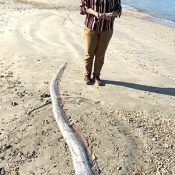
March 17, 2022 Ryukyu Shimpo
By Hideki Matsudo
Kunigami – A deep-sea giant oarfish (also known as king of herrings) was found washed up on the beach in Kaganji, Kunigami on March 14.
The fish measured 2.7 meters in length. The fish was discovered by Uruma City business owner Shusei Teruya, 58, and his wife Hatsumi, 58. Shusei said, “At first we thought it was a moray eel, but it had a red fin and something that looked like a cockscomb, and was surprised to realize it was a giant oarfish, which I had seen on TV.”
A giant oarfish has a long and slender body like a snake, and is characterized by the long red fin extending down its body from its head. As a deep-sea fish, it is rare for one to be seen by people, however in the past people have occasionally caught them when fishing in the middle of the Sea of Japan.
Shinichiro Oka, head of the Okinawa Churashima Foundation Research Center, who confirmed the fish’s species at the beach, said, “Without doing a detailed investigation, it will be hard to determine why it washed ashore.”
(English translation by T&CT and Sam Grieb)
Go to Japanese
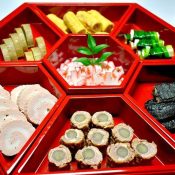
March 16, 2022 Ryukyu Shimpo
By Takahiro Kina
Kitanakagusuku – On February 22, the Kitanakagusuku Tourism Association held two monitoring tour events at the Nakamura House, which has been designated an important cultural asset in Japan. The events were held one in the afternoon and one in the evening, and gave guests the chance to enjoy the cuisine of the Ryukyu royal court.
Chef Hiroyuki Teruya, who is head chef at the Kurashi no Hakko Lifestyle Resort in Kishaba and is certified to teach about the traditional food culture of the Ryukyu Islands, was in charge of the menu. He offered guests foods that would have been eaten by the court, as well as foods that would have bee
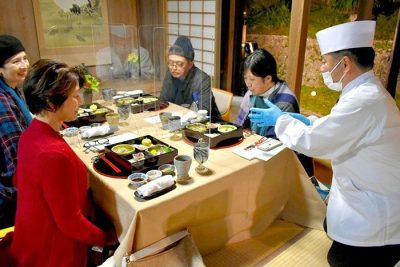
Participants listen as Chef Hiroyuki Teruya (furthest right) explains the various dishes (February 22, Nakamura House (an important cultural asset) in Kitanakagusuku)
n eaten by commoners in the days of the Ryukyu Kingdom.
During the evening event, Teruya recreated the hospitality of Baron Sho Jun, a gourmet and the fourth son of Sho Tai, the last king of the Ryukyu Kingdom, by serving guests minudaru (pork in black sesame sauce), a dish that would have been eaten by the court, from a traditional Ryukyuan lacquered serving tray called a tundabun. Guests also enjoyed other foods such as itamirukuju, a dish of Okinawan tofu that has been brined in salt water, dried in the sun, and fermented.
One of the participants, Miyuki Nakamura of Urasoe, says, “I attended as a treat for myself. The irabu (Chinese sea snake) soup was mild and delicious.”
(English translation by T&CT and Ellen Huntley)
Go to Japanese

March 13, 2022 Ryukyu Shimpo
By Tsuyoshi Arakaki
The Gorbachev Foundation, led by the 91-year-old former Soviet Union president Mikhail Gorbachev, issued a statement concerning the Russian invasion of Ukraine, which began on February 26: “We affirm the need for an early cessation of hostilities and immediate start of peace negotiations.”
The statement further conveyed, “There is nothing more precious in the world than human lives. Negotiations and dialogue on the basis of mutual respect and recognition of interests are the only possible way to resolve the most acute contradictions and problems.” In the statement, the foundation also called for expeditious peace talks: “We support any efforts aimed at the resumption of negotiating process.”
Gorbachev’s mother and his late wife Raisa were Ukrainian, and many of Raisa’s relatives still reside in Ukraine. The former USSR leader has remarked, “someone is provoking hostility between Russia and Ukraine, has a tremendous interest in corrupting the two nations’ relationship, and is seeking instability in the region.” Mikhail Gorbachev has visited Okinawa three times in the past.
(English translation by T&CT and Monica Shingaki)
Go to Japanese

March 14, 2022 Ryukyu Shimpo
By Teppei Ikeda
In a pre-event for the “7th Worldwide Uchinanchu Festival,” which is scheduled to start October 30, Kira Beckford from the Okinawa Kai of Washington DC was given an award of excellence in a drawing contest held by Okinawa Prefecture for her drawing titled “Okinawa of the World.” Beckford’s artwork is going to be used in things like large-print posters.
Beckford’s mother is from Okinawa. The winning artwork has an Okinawan-themed background that includes Akagawara roofing tiles, whale sharks, and hibiscus flowers, and depicts a collection of smiling Okinawans from all over the globe. She said that for her drawing she, “wanted to show that the Uchinanchu DNA cross
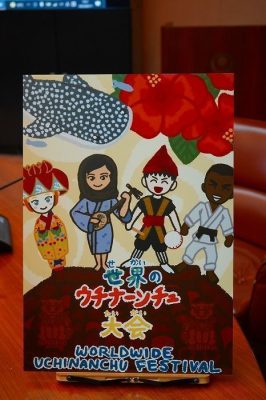
The Worldwide Uchinanchu Festival picture contest winning entry, made by Kira Beckford from the Okinawa Kai of Washington DC
es the borders of many countries and connects people from different places.”
On March 11, there was a “digital award ceremony” held at the Okinawa Prefectural Office connecting online over video conference to the U.S., where Okinawa governor Denny Tamaki awarded Beckford an award certificate and medal. Governor Tamaki said, “The picture is full of imagery filled with Uchinanchu DNA, and shows the importance of bonds between people. It is fitting for this year’s festival, which will also mark the 50th anniversary of the reversion [of Okinawa from U.S. control back to Japan].
The contest collected pictures from July through December of last year from children who belonged to different Okinawa Kai organizations both in Japan and abroad, as well as students from schools in Okinawa. They received 50 submissions
(English translation by T&CT and Sam Grieb)
Go to Japanese

March 11, 2022 Ryukyu Shimpo
Ryota Shimabukuro
On March 10, the Okinawa branch of the Naha District Court handed down its decision in the “second Futenma lawsuit”, in which 3,193 residents of the area surrounding Marine Corps Air Station (MCAS) Futenma claim to have experienced noise damage from the air station, and are requesting damages from the central government. Presiding Judge Kenta Adachi awarded these damages, and ordered the central government to pay 150 yen per day to residents of areas experiencing a Weighted Equivalent Continuous Perceived Noise Level (or W value) of 75 or more, and 300 yen per day to residents of areas experiencing a W value of 80 or more. The amount of compensation per person comes to the same level as from the first such lawsuit. The total amount of damages awarded comes to 1,342,740,000 yen.
The decision included the statement that the use of Futenma Air Station necessarily has a public nature and needs to serve public interest. However, the decision also contained mention, as concerns the choice to award damages, that the use of Futenma Air Station also “produces striking injustice in relation to the general public.” Furthermore, the decision also contains mention that even though Japan is making efforts such as pursuing soundproofing work, “it cannot be said that Japan is taking drastic measures” concerning the noise, and ordered that compensation be paid for psychological damage to residents, such as sleep disturbances and apprehension concerning accidents.
However, the plaintiffs’ claim for compensation for damage to health, anxiety about damage to health, and anxiety about the negative impact on their children and grandchildren was dismissed. The impact of low-frequency sounds was also not recognized. The amount of compensation is to be reduced by 10-30 percent depending on the implementation status of the soundproofing work.
Kenei Yamashiro, the head plaintiff, said, “The noise has gotten more intense since the suit was presented four years ago. We are not satisfied with the decision, and are considering an appeal.”
The Okinawa Defense Bureau, having been ordered to pay a portion of the compensation, issued the comment that, “We accept that we did not gain the court’s understanding. We will give careful consideration to our handling [of these matters] moving forward.”
(English translation by T&CT and Erin Jones)
Go to Japanese
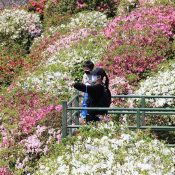
March 10, 2022 Ryukyu Shimpo
By Naoya Oshiro
The azaleas at Higashi Azalea Eco Park are in full bloom, delighting the eyes of visitors to the park. March 9 was blessed with great weather, and families could be seen out taking pictures and enjoying themselves against a vivid backdrop of red, pink, and white.
The “40th annual Higashi Azalea Festival” has also been underway since March 1 at the park, and the festivities were greeted by the blooming of the colorful flowers, including the Kerama azalea. According to the park, this week is the best week to come see the flowers.
(English translation by T&CT and Sam Grieb)
Go to Japanese














 Webcam(Kokusai Street)
Webcam(Kokusai Street)


